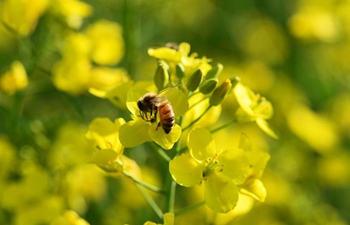by Xinhua writer Yuan Quan
BEIJING, Jan. 23 (Xinhua) -- The Beijing Wildlife Rescue and Rehabilitation Center is asking bird lovers across the city to volunteer for the upcoming annual survey of Beijing swifts.
Volunteers will be trained to administer the survey, learn about the bird's habits and observe and photograph birds once a week from March to July this year, according to a release from the center, led by the Beijing municipal forestry department.
A recruitment plan posted on social media by the center earlier in January said 80 volunteer surveyors are needed.
"The survey's goal is to find the bird's population, nesting sites and breeding rates, as well as their feeding grounds. The more we know, the better protection we can offer," said Shi Yang, researcher of the center and lead of the swift survey.
Since 2017, more than 150 volunteers have participated in the birds' survey, discovering 25 nesting sites in urban Beijing.
"Apart from the widely distributed sites, we find that the swifts are usually active in the evening, but we are understaffed, so we need volunteers to contribute data," Shi said.
In 1870, the bird was first described by a British naturalist as a subspecies of the common swift and was named the Beijing swift. Ornithologists see swifts as "supreme aerialists" with very narrow long wings, ranking them among the fastest animals on the planet, spending most of their lives in the air.
Because they seldom land on the ground and they are so fast and so aerial, swifts are very hard to study. "We know very little about the bird," Shi said.
The swift has long had a close relationship with people. Ornithologists say people in ancient times would forecast the weather by their behavior. For example, low-flying swifts would mean a storm was coming.
"The swifts have a special place in the hearts of Beijingers," said Fu Jianping, former president of the China Bird Watching Society.
She remembered the scene 20 years ago when hundreds of Beijing swifts hovered over the Qianmen Gate Tower near Tiananmen Square.
The birds like to nest in high buildings with eaves such as city gatehouses and imperial garden buildings. They can be seen at the Forbidden City, the Lama Temple and the Summer Palace from mid-April to July every year.
"Their twittering flight at dusk around many of our major landmarks is one of the most enchanting features of our summer," said Fu.
In recent years, many important discoveries about the birds have been revealed due to public engagement.
In 2016, the birds' migration was first revealed after a group of Chinese and foreign scientists worked with bird watchers and environmental NGOs on a year-long study. They fit tracking devices to dozens of the birds and discovered that the swifts travel more than 13,000 km to winter in southern Africa before returning to breed in Beijing in the spring and summer.
Last year, surveys conducted by volunteers showed that there were at least 4,000 swifts before the breeding season (mid-June) and 6,500 after the breeding season (late June) in Beijing.
In addition, they found that more swifts nest in modern buildings, such as flyovers, with no particular preference for ancient architecture, indicating that birds are gradually adapting to urbanization.
The bird surveys have raised public protection awareness of wildlife. According to Shi, most volunteer surveyors are teenagers and their parents.
Zhang Zhecai, 44, has volunteered for the survey with his son since 2017. He loves watching birds and finds the surveys are a good science education activity to learn about a local species and the environment changes of a city.
"The surveys have also fostered my boy's scientific spirit, which is very meaningful," Zhang said.

















